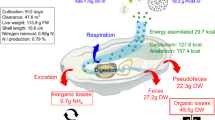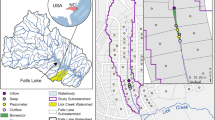Abstract
The nature of the nutrient budget for temporary rivers differs from that for permanent rivers because of the restricted nature of flow, the lack of adequate dilution, and weather conditions which are conducive to the development of algal blooms. We analyse the nutrient budget of three tributaries of a temporary river in Cyprus, the Kouris, with the aid of the MONERIS model. MONERIS in-stream retention module was modified to account for a 1-dimensional advection - dispersion pollutants transport rather than the general mass balance equation for mixed reactors. TRS plot classified Kryos stream as an Intermittent flow – Dry (I-D) stream (hydrologically altered) and Kouris and Limnatis as Intermittent – Pool (I-P) streams that need different lumped parameterization in MONERIS simulation. Point sources are important for nitrogen (64 %) and phosphorous emissions (22 %), and diffuse sources for nitrogen via erosion (15 %) and free grazing (12 %) and for phosphorous via free grazing (8 %). We estimate that around 40 % of N and 88 % of P entering streams is retained in the stream. An analysis of the model uncertainty and sensitivity to input data indicates that MONERIS model, even in semi-arid areas, may be used for the purpose of managing river basins.



Similar content being viewed by others
References
Arnold J, Allen P (1999) Automated methods for estimating base flow and ground water recharge from stream flow records. J Am Water Resour Assoc 35(2):411–424
Arnold JG, Srinivasan R et al (1998) Large area hydrologic modelling and assessment part I: model development. J Am Water Res Assoc 34(1):73–89
Baker DB, Richards RP, Loftus TT, Kramer JW (2004) A new flashiness index: Characteristics and applications to Midwestern rivers and streams. Journal of the American Water Resources Association 40(2):503-22
Bernal S, von Schiller D et al (2013) Hydrological extremes modulate nutrient dynamics in Mediterranean climate streams across different spatial scales. Hydrobiologia 719(1):31–42
Bicknell B R, Imhoff J C et al (2001) “Hydrological Simulation Program-Fortran, HSPF, Version 12, User’s Manual.” (March 2001, Athens: National Exposure Research Laboratory, Office of Research and Development)
Boronina A, Renard P et al (2003) Groundwater resources in the Kouris catchment (Cyprus): data analysis and numerical modelling. J Hydrol 271(1–4):130–149
Boronina A, Balderer W et al (2005) Study of stable isotopes in the Kouris catchment (Cyprus) for the description of the regional groundwater flow. J Hydrol 308(1–4):214–226
Bouraoui F, Grizzetti B et al (2009) “Nutrient discharge from rivers to seas for year 2000.” JRC Scientific and Technical Reports 54459
Caille F, Riera JL et al (2012) Modelling nitrogen and phosphorus loads in a Mediterranean river catchment (La Tordera, NE Spain). Hydrol Earth Syst Sci 16(8):2417–2435
Camargo JA, Alonso Á (2006) Ecological and toxicological effects of inorganic nitrogen pollution in aquatic ecosystems: a global assessment. Environ Int 32(6):831–849
Chahinian N, Bancon-Montigny C et al (2013) Temporal and spatial variability of organotins in an intermittent Mediterranean river. J Environ Manag 128:173–181
Colwell RK (1974) Predictability, constancy and contingency of periodic phenomena Ecology 55: 1148-1153
De Girolamo AM, Calabrese A et al (2012) Impact of anthropogenic activities on a temporary river. Fresenius Environ Bull 21(11):3278–3286
Fleskens L, Graaff JD (2010) Conserving natural resources in olive orchards on sloping land: Alternative goal programming approaches towards effective design of cross-compliance and agri-environmental measures. Agricultural Systems 103(8):521-34
Gallart F, Prat N et al (2012) A novel approach to analysing the regimes of temporary streams in relation to their controls on the composition and structure of aquatic biota. Hydrol Earth Syst Sci 16(9):3165–3182
Grizzetti B, Bouraoui F et al (2008) “Assessing nitrogen pressures on European surface water.” Global Biogeochemical Cycles 22(4)
Hirt U, Venohr M et al (2008) Modelling nutrient emissions and the impact of nutrient reduction measures in the Weser river basin, Germany. 58: 2251–2258
Hirt U, Kreins P et al (2012) Management options to reduce future nitrogen emissions into rivers: a case study of the Weser river basin, Germany. Agric Water Manag 115:118–131
Hofstra N, Bouwman AF (2005) “Denitrification in agricultural soils: summarizing published data and estimating global annual rates.”. Nutr Cycl Agroecosyst 72:267–278
Kowalkowski T (2009) Classification of nutrient emission sources in the Vistula River system. Environ Pollut 157(6):1867–1872
Kowalkowski T, Pastuszak M et al (2012) Differences in emission of nitrogen and phosphorus into the Vistula and Oder basins in 1995–2008 - natural and anthropogenic causes (MONERIS model). J Mar Syst 89(1):48–60
Matias NG, Johnes PJ (2012) Catchment phosphorous losses: an export coefficient modelling approach with scenario analysis for water management. Water Resour Manag 26(5):1041–1064
McKee T B, Doesken N J et al (1993) “The relationship of drought frequency and duration to time scales.” 8th Conference on Applied Climatology, Anaheim, CA. 17–22 January(179–184)
Medis (2005) “Institutional analysis of water management practices Majorca-Corcia-Sicily-Crete-Cyprus.” Project No. EVK1-CT-2001-0009
Moyle P B (2013) “NOVEL AQUATIC ECOSYSTEMS: THE NEW REALITY FOR STREAMS IN CALIFORNIA AND OTHER MEDITERRANEAN CLIMATE REGIONS.” River Research and Applications
Nash JE, Sutcliffe JV (1970) River flow forecasting through conceptual models part I-A discussion of principles. J Hydrol 10:282–290
Nikolaidis C (2010) “Update of the project of the environmental impact assessment of the Akrotiri aquifer replenishment with recycled wastewater of Limassol – Amathountos” TAY 74/2009
Nikolaidis NP, Karageorgis AP et al (2009) Management of nutrient emissions of Axios River catchment: their effect in the coastal zone of Thermaikos Gulf, Greece. Ecol Model 220(3):383–396
Nikolaidis NP (2011) Human impacts on soils: Tipping points and knowledge gaps. Applied Geochemistry 26(SUPPL.):S230-S3
OECD (2007) “Environmental indicators for agriculture.” Volume 4(Paris, France.)
Pastuszak M, Stålnacke P et al (2012) Response of Polish Rivers (Vistula, Oder) to reduced pressure from point sources and agriculture during the transition period (1988–2008). J Mar Syst 94:157–173
Panagos P, Van Liedekerke M, Jones A, Montanarella L (2012) European Soil Data Centre: response to European policy support and public data requirements. Land Use Policy 29(2):329–338
Perrin J L, Tournoud M G (2009) “Hydrological processes controlling flow generation in a small Mediterranean catchment under karstic influence.” Processus hydrologiques contrôlant la génération des débits dans un petit bassin versant Méditerranéen sous influence karstique 54(6): 1125–1140
Ragab R, Bromley J (2010) IHMS-integrated hydrological modelling system. Part 1. Hydrological processes and general structure. Hydrol Process 24(19):2663–2680
Ramazanipour M, Roshani M et al (2011) The relationship of drought intensity, duration and frequency in the southern coast of Caspian Sea. World Appl Sci J 15(8):1176–1180
Richter BD, Baumgartner JV, Braun DP, Powell J (1998) A spatial assessment of hydrologic alteration within a river network. River Research and Applications 14(4):329-40
Rosado J, Morais M et al (2012) Key Factors in the Management and Conservation of Temporary Mediterranean Streams: A Case Study of the Pardiela River, Southern Portugal: 273–283
Santos JF, Portela MM et al (2011) Regional frequency analysis of droughts in Portugal. Water Resour Manag 25(14):3537–3558
Smil V (2001) “Enriching the Earth: Fritz Haber, Carl Bosch, and the transformation of world food production.”. MIT Press, Cambridge, p xvii338
Tsakiris G, Vangelis H (2004) Towards a Drought watch system based on spatial SPI. Water Resour Manag 18(1):1–12
Tzoraki O, Nikolaidis NP (2007) A generalized framework for modeling the hydrologic and biogeochemical response of a Mediterranean temporary river basin. J Hydrol 346(3–4):112–121
Tzoraki O, Nikolaidis NP et al (2009) A reach-scale biogeochemical model for temporary rivers. Hydrol Process 23(2):272–283
Tzoraki O, Dörflinger G et al. (2012) “Controlling Pollution Risk of an important Drinking Water Reservoir in a strongly human altered and climatically induced semi-arid environment.” 3nd International Conference on Industrial and Hazardous Waste Management, 10–14 September 2012 (Chania, Crete)
Uys MC, O’Keeffe JH (1997) Simple words and fuzzy zones: early directions for temporary river research in South Africa. Environ Manag 21(4):517–531
Venohr M, Hirt U et al (2011) Modelling of nutrient emissions in river systems - MONERIS - methods and background. Int Rev Hydrobiol 96(5):435–483
Von Schiller D, Martí E et al (2008) Inter-annual, annual, and seasonal variation of P and N retention in a perennial and an intermittent stream. Ecosystems 11(5):670–687
Waschbusch R J, Selbig W R et al (1999) “Sources of Phosphorus in Stormwater and Street Dirt from Two Urban Residential Basins In Madison, Wisconsin, 1994–95”
Webb JA, Nichols SJ et al (2012) Ecological responses to flow alteration: assessing causal relationships with eco evidence. Wetlands 32(2):203–213
Zessner M, Kovacs A et al (2011) Enhancement of the MONERIS model for application in alpine catchments in Austria. Int Rev Hydrobiol 96(5):541–560
Zhai J, Su B et al (2010) Spatial variation and trends in PDSI and SPI indices and their relation to stream flow in 10 large regions of China. J Clim 23(3):649–663
Acknowledgments
The authors wish to thank Dr. Charles Demetriou from the Cyprus Water Development Department for the data contribution and his valuable comments towards the improvement of this manuscript. This work is partly funded by the SoilTrEC 7th FP (Grant Agreement No. 244118).
Author information
Authors and Affiliations
Corresponding author
Rights and permissions
About this article
Cite this article
Tzoraki, O., Cooper, D., Dörflinger, G. et al. A new MONERIS in-Stream Retention Module to Account Nutrient Budget of a Temporary River in Cyprus. Water Resour Manage 28, 2917–2935 (2014). https://doi.org/10.1007/s11269-014-0646-7
Received:
Accepted:
Published:
Issue Date:
DOI: https://doi.org/10.1007/s11269-014-0646-7




